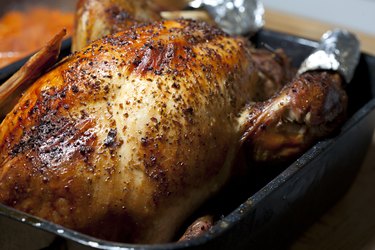
Anyone who wants to prepare a good ol' traditional turkey dinner at holiday time (or any other time, for that matter) has to deal with the stuff that's stuffed inside the bird – in other words, that package of turkey giblets and the turkey neck. The frugal cook doesn't throw out any of these tidbits, since you can use all of it.
First, Thaw the Turkey
Video of the Day
The turkey giblets and the neck can be found in the turkey's neck cavity (to the front) or body cavity (to the back) of just about any whole bird you see at the supermarket. Most of these are frozen, and you must thoroughly thaw a frozen turkey before attempting to remove the inner bits. If you try to take them out too soon, the turkey will still be frozen inside, and these parts will get stuck. The plastic or paper package they're packaged in might tear, shred or stick – and, in general, become a mess to deal with.
There are a few different ways to thaw a frozen turkey. Figure on approximately 24 hours in the fridge for every 4‒5 pounds, or 30 minutes per pound in cold water. The cold water method – usually done in the sink – is quicker than thawing your turkey in the fridge, but it's also more of a chore, since you have to change the water about every 30 minutes. Salmonella contamination is, unfortunately, a possibility that you have to take into account while the turkey thaws, so be careful with it. Just be sure that it's kept separate from other food and food-preparation areas.
Removing the Turkey Neck
Of all the parts of a turkey, the neck is probably the ugliest. It strains credulity to think that it might even be worth saving. That is, after you get it out of the bird to begin with. How is that accomplished?
When your turkey is all thawed out, reach inside the turkey where the package of giblets and neck can be found. Check both cavities; you don't want to leave anything behind. When you've found the giblets and neck, gently work your hand around them and gradually pull them out. If the turkey has been properly thawed, this should be easy.
You can use the heart, liver and gizzard to make giblet gravy. Note that some folks don't use the liver for this purpose, believing that it adds an odd, bitter note to the gravy. Many people use the neck either as another part of the giblet gravy or as a base for broth, stock or soup.
Stock vs. Broth
The main difference between a stock and a broth is that stock needs bones, and broth, which is made with meat only, does not. They're both heated in water that's brought to a boil and then simmered. While a broth usually needs to simmer just an hour or so, a stock needs more time – up to four hours – to allow all the nutrition from the bone marrow to permeate the liquid and for the collagen to become gelatinous and thick. Thus, a stock has more body and richness than broth.
Note that you won't get much stock from one turkey neck. If you want to make the most of your bird, use the remains of the carcass along with the neck.
Turkey Neck on Its Own
Since the neck has quite a lot of meat on it, you can also prepare it as a dish on its own. To do this, use a sharp boning knife to divide the neck into 3-inch segments. Brown the segments in a skillet and then finish the dish in the oven. Some people compare the texture of turkey neck meat to that of short ribs. And, just like ribs, you can pick up the pieces with your hands and gnaw the tender meat down to the bone.
Sorry, Dogs – No Turkey Neck for You
Don't fall for the notion that turkey neck, either raw or cooked, is a suitable treat for dogs. The bones are too large, and raw neck may cause salmonella poisoning. Cooked neck bones, aside from being large, are too brittle and might break into dangerously sharp shards.
Check out this related video from ExpertVillage on Youtube
- Moms Dish: Turkey Necks Recipe
- The Morning Call: Thanksgiving meal mishaps, from forgotten giblets to deceased ovens, don't have to ruin the holiday
- My Fearless Kitchen: What's That Stuff Inside My Turkey?
- U.S. Dept. of Agriculture Food Safety and Inspection Service: Giblets and Food Safety
- Alton Brown: The Difference Between Stocks and Broths